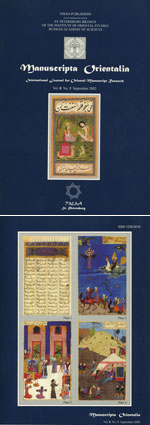|
|
| |

|

|
Vorobyova-Desyatovskaya M. A Sanskrit Manuscript on Birch-bark from Bairam-Ali. II. Avadāna and Jātaka (Part 8) // Manuscripta Orientalia. Vol. 8. No. 3. September 2002. P. 26—33.
As we have seen earlier, the text of the Bairam-Ali manuscript contains a large number of Prakrit grammatical forms. For example, in place of Skt. satvaih, Instr. Pl., we find the form satvehi, which goes back to satvebhih. We find -ehi, in place of -ebhih and -aih; which is one of the most widespread Prakrit grammatical forms, repeated almost invariably throughout the text. Especially frequent are violations of the samdhi rule, for example, kin tayā and kin tena instead of Skt. kims tayā and kims tena. Also, many verb forms — aorist forms, for example — are given incorrectly.
A textual comparison with avadānas with the same plotline shows that the text in the manuscript is abbreviated and simplified. One is tempted to conclude that the stories outlined in note form in the manuscript hark back to an earlier folkloric layer that was further developed in alter avadânas. The language would have been intentionally “Sanskritized” to grant it legitimacy by making it similar to the language of classical Sanskrit literature.
In two recently published articles, Prof. Seishi Karashima (Tokyo) analyzes the grammatical features of a number of Sanskrit texts recorded in the fifth - ninth centuries. He notes departures from standard Sanskrit in orthography, phonology, syntax, and morphology and identifies several forms reflected neither in BHSD nor in BHSG, but which came to be standard for the Buddhist Sanskrit of the period under discussion. Seishi Karashima concludes that the language of many Buddhist texts (e.g., the earliest extant version of the Lotus Sutra that we find in the Lushun fragments of the sutra) was originally not Sanskrit, but Prakrit (the Indian vernacular of the medieval period), only later “Sanskritized” when they were recorded in written form. It seems that the Bairam-Ali manuscript may confirm Karashima’s conclusion. But, of course, its language needs additional and thorough intensive study...
К содержанию выпуска...
 PDF-файлы PDF-файлы
Полный текст статьи
Ключевые слова
коллекция ИВР РАН: издания
коллекция ИВР РАН: переводы
коллекция ИВР РАН: факсимиле
литература буддийская
рукописи санскритские
фонд сериндийский
|
|
|
|
Случайная новость: Объявления |
|
ВНИМАНИЕ читателям Библиотеки ИВР РАН! C 3 февраля по 4 марта 2025 г. проводится перерегистрация читателей. |
|
Подробнее...
|
|
|
|
|

